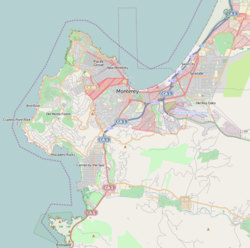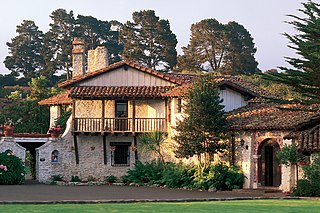
Monterey is a city located in Monterey County on the southern edge of Monterey Bay on the U.S. state of California's Central Coast. Founded on June 3, 1770, it functioned as the capital of Alta California under both Spain and Mexico. During this period, Monterey hosted California's first theater, public building, public library, publicly-funded school, printing-press, and newspaper. It was originally the only port of entry for all taxable goods in California. In 1846, during the Mexican–American War of 1846–1848, the United States Flag was raised over the Customs House. After Mexico ceded California to the U.S. at the end of the war, Monterey hosted California's first constitutional convention in 1849.

John Drake Sloat was a commodore in the United States Navy who, in 1846, claimed California for the United States.

The Battle of Monterey, at Monterey, California, occurred on 7 July 1846, during the Mexican–American War. The United States captured the town unopposed.

Californio is a term used to designate a Hispanic Californian, especially those descended from Spanish and Mexican settlers. California's Spanish-speaking community has resided there since 1683 and is made up of varying Spanish, Mexican, Mestizo, and Indigenous Californian origins. Alongside the Tejanos of Texas and Neomexicanos of New Mexico and Colorado, Californios are part of the larger Chicano/Mexican-American/Hispano community of the United States, which has inhabited the American Southwest and the West Coast since the 16th century.

The Ávila Adobe, built in 1818 by Francisco Ávila, is the oldest standing residence in the city of Los Angeles, California. Avila Adobe is located in the paseo of historic Olvera Street, a part of the Los Angeles Plaza Historic District, a California State Historic Park. The building itself is registered as California Historical Landmark #145, while the entire historic district is both listed on the National Register of Historic Places and as a Los Angeles Historic-Cultural Monument.

A California Historical Landmark (CHL) is a building, structure, site, or place in California that has been determined to have statewide historical landmark significance.
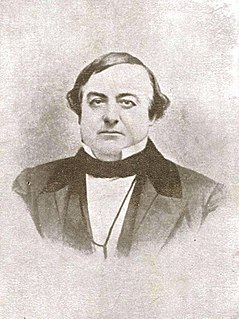
Juan Bautista Valentín Alvarado y Vallejo was a Californio politician that served as Governor of Alta California from 1837-42. Prior to his term as governor, Alvarado briefly led a movement for independence of Alta California from 1836-37, in which he successfully deposed interim governor Nicolás Gutiérrez, declared independence, and created a new flag and constitution, before negotiating an agreement with the Mexican government resulting in his recognition as governor and the end of the independence movement.

Monterey State Historic Park is a historic state park in Monterey, California. It includes part or all of the Monterey Old Town Historic District, a historic district that includes 17 contributing buildings and was declared a National Historic Landmark in 1970. The grounds include California's first theatre, and the Monterey Custom House, where the American flag was first raised over California.
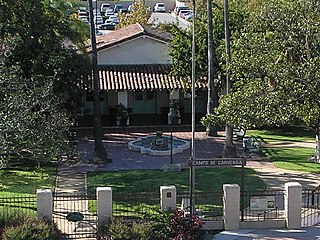
The Campo de Cahuenga, near the historic Cahuenga Pass in present-day Studio City, California, was an adobe ranch house on the Rancho Cahuenga where the Treaty of Cahuenga was signed between Lieutenant Colonel John C. Frémont and General Andrés Pico in 1847, ending hostilities in California between Mexico and the United States. The subsequent Treaty of Guadalupe Hidalgo of 1848, ceding California, parts of Colorado, Nevada, New Mexico, and Arizona to the United States, formally ended the Mexican–American War. From 1858 to 1861 the Campo de Cahuenga became a Butterfield Stage Station.

Thomas Oliver Larkin, known in Spanish as Don Tomás Larkin, was an American diplomat and businessman. Larkin served as the only U.S. consul to Alta California during the Mexican era and was covertly involved in U.S. plans to annex California from Mexico. Following the American Conquest of California and the end of the Mexican-American War, Larkin was a delegate to the Monterey Constitutional Convention in 1849 and a signatory of the Constitution of California.

The Cathedral of San Carlos Borromeo, also known as the Royal Presidio Chapel, is a Roman Catholic cathedral located in Monterey, California, United States. The cathedral is the oldest continuously operating parish and the oldest stone building in California. It was built in 1791-94 making it the oldest serving cathedral in the United States, along with St. Louis Cathedral in New Orleans, Louisiana. It is the only existing presidio chapel in California and the only existing building in the original Monterey Presidio.

José Antonio Castro was a Californio politician, statesman, and general who served as interim Governor of Alta California and later Governor of Baja California. During the Bear Flag Revolt and the American Conquest of California, Castro led Mexican forces as the Commandante General of Northern California.

The history of California can be divided into: the Native American period, the European exploration period (1542–1769), the Spanish colonial period (1769–1821), the Mexican period (1821–1848), and United States statehood. California was one of the most culturally and linguistically diverse areas in pre-Columbian North America. After contact with Spanish explorers, most of the Native Americans died out from European diseases and genocide campaigns.
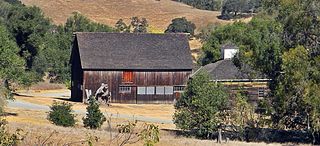
Olompali State Historic Park is a 700-acre (2.8 km2) California State Park in Marin County, California. It is constituted of the former Rancho Olómpali and was the site of the famed Battle of Olómpali during the Bear Flag Revolt. Rancho Olómpali was purchased by the Californian government in 1977, which turned it into a public park.

The José Castro House, sometimes known as the Castro-Breen Adobe, is a historic adobe home in San Juan Bautista, California, facing the Plaza de San Juan. The Monterey Colonial style house was built 1838-41 by General José Antonio Castro, a former Governor of Alta California. It was later sold to the Breen family, who lived there until 1933, when the house became a museum as part of San Juan Bautista State Historic Park.

Yerba Buena was the original name of the settlement that later became San Francisco, California. Located near the northeastern end of the San Francisco Peninsula, between the Presidio of San Francisco and the Mission San Francisco de Asís, it was originally intended as a trading post for ships visiting San Francisco Bay. The settlement was arranged in the Spanish style around a plaza that remains as the present day Portsmouth Square.

The Larkin House is a historic house at 464 Calle Principal in Monterey, California. Built in 1835 by Thomas O. Larkin, it is claimed to be the first two-story house in all of California, with a design combining Spanish Colonial building methods with New England architectural features to create the popular Monterey Colonial style of architecture. The Larkin House is both a National and a California Historical Landmark, and is a featured property of Monterey State Historic Park.
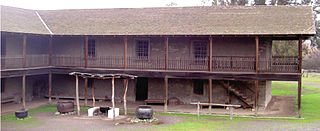
Monterey Colonial is an architectural style developed in Alta California. Although usually categorized as a sub-style of Spanish Colonial style, the Monterey style is native to the post-colonial Mexican era of Alta California. Creators of the Monterey style were mostly recent immigrants from New England states of the US, who brought familiar vernacular building styles and methods with them to California.

The Conquest of California, also known as the Conquest of Alta California or the California Campaign, was an important military campaign of the Mexican–American War carried out by the United States in Alta California, then a part of Mexico. The conquest lasted from 1846 into 1847, until military leaders from both the Californios and Americans signed the Treaty of Cahuenga, which ended the conflict in California.

The Sonoma Barracks is a two-story, wide-balconied, adobe building facing the central plaza of the City of Sonoma, California. It was built by order of Mariano Guadalupe Vallejo to house the Mexican soldiers that had been transferred from the Presidio of San Francisco in 1835. The Presidio Company and their commander, Vallejo, were also responsible for controlling the Native Americans living on the northern border of Mexican California.

